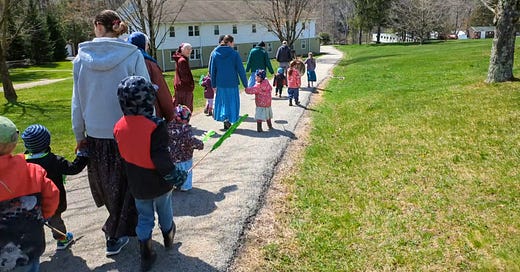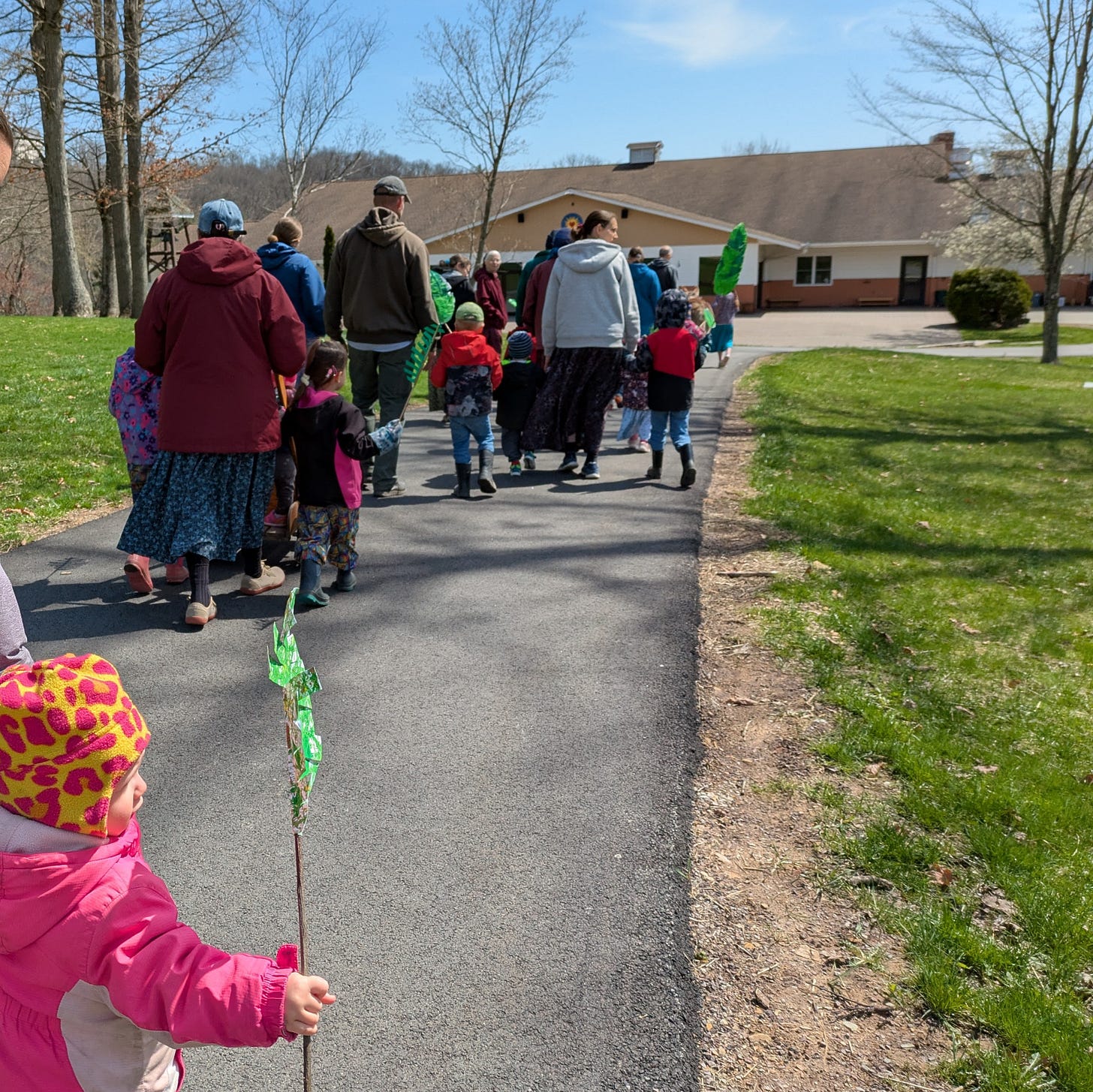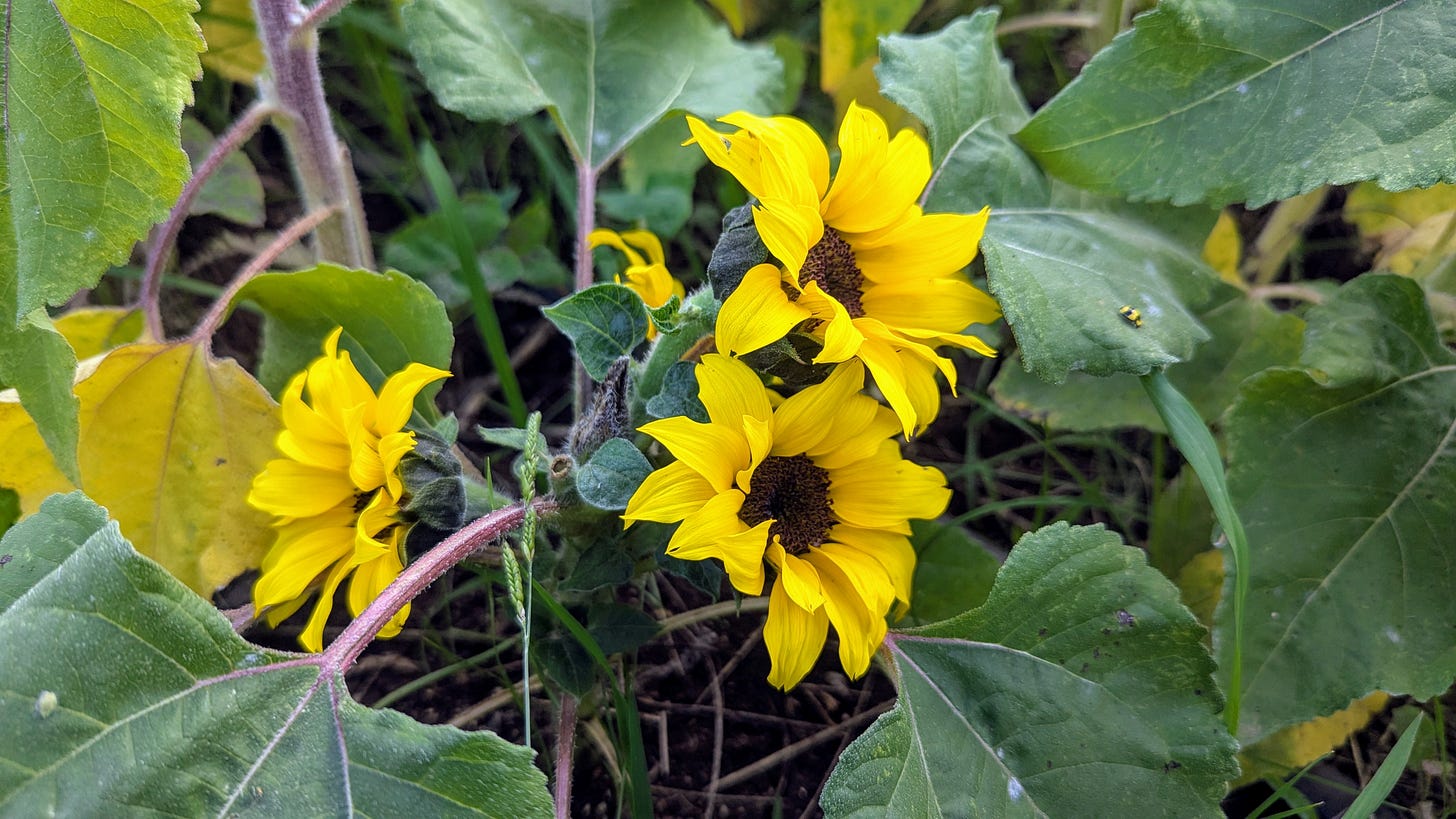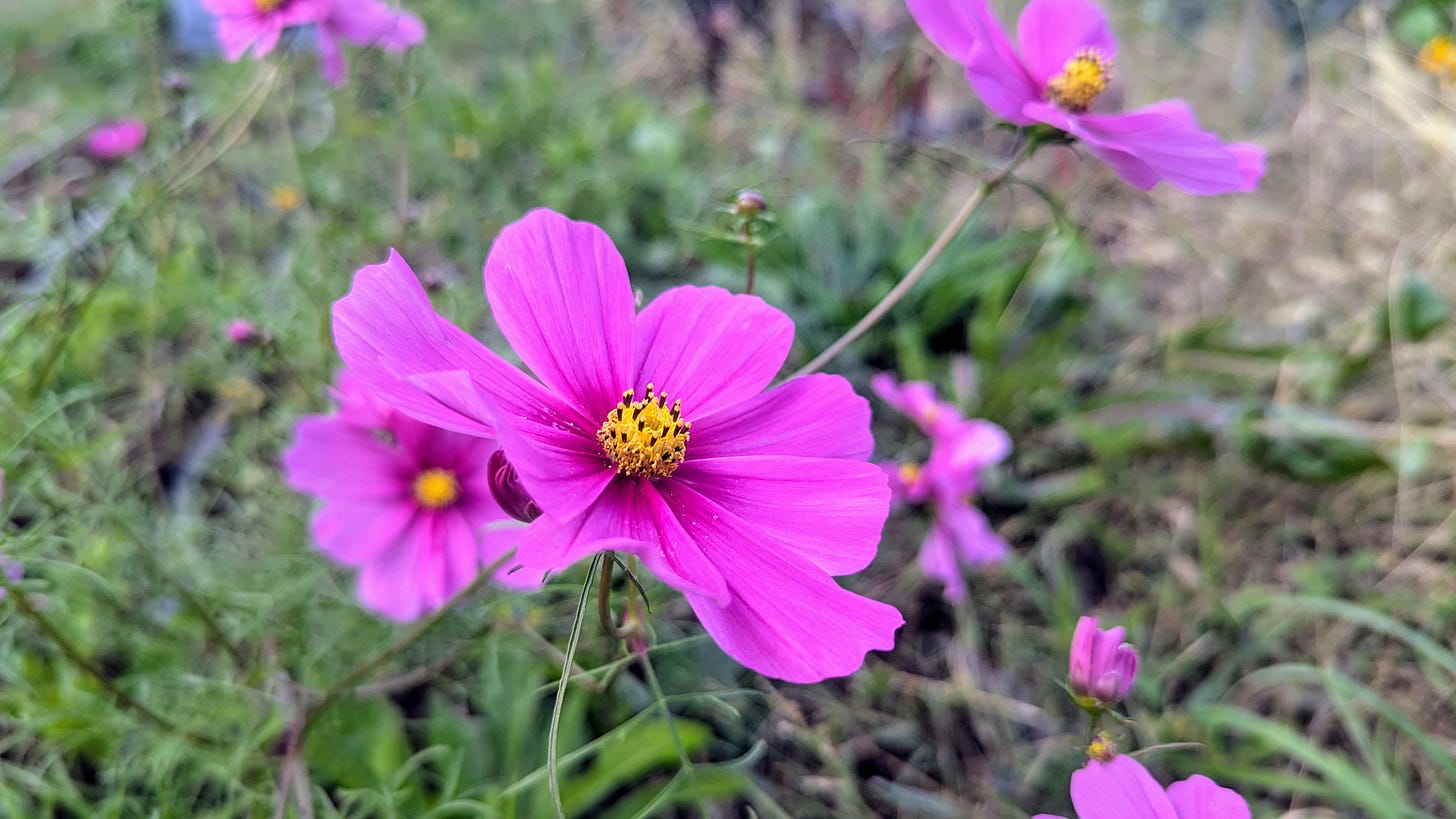Welcome back readers, and welcome, new readers –
If you visit one of our communities you are almost sure to hear us singing together, whether at mealtimes in the communal dining hall or in our worship services. Children sing together in classrooms and at weekly school assemblies, and most families end the day by singing a song or two with their children before bedtime. Some of these songs are religious, but many are simple folk songs that express joy in nature, companionship, or the events of life. There are songs to sing in the morning and in the evening, songs to celebrate each season, and of course songs for Christmas and Easter.
The Easter songs have been collected into a book of over 170 songs, and an important part of our community experience of this holy season is in song. Below, each of us has written about a couple of our favorites; some of the best loved songs (including many we mention below) were recorded by a youth choir several years ago so you can sing along – or better yet, come visit us and we’ll sing together.
(For a little more about our Easter celebrations, read here.)
Trudi – in Spring Valley, southwest Pennsylvania
Recently, I’ve begun teaching part time in Spring Valley community’s PreK again. From 1 pm to 4 pm, I have seven 3- and 4-year-olds under my care. Of course, for some people that might be a nightmare, but I love it. A few weeks ago we made palm branches: ripped tissue paper, smeared glue around with a paint brush, stuck the tissue paper on and taped sticks inside. They look like green canoe paddles but the kids were happy and proud of their work.
This week all the community’s children, from the babies to the 4-year-olds, invited any parents or grandparents who could to join us for a short walk following a donkey and singing Palm Sunday songs.
“Ride on, King Jesus” is top of the charts. Although some kids are a little puzzled by the meaning of those words, they sing it wholeheartedly. I’ve come to love it for my own reasons. Particularly one verse,
Don't lose courage in the fight,
No man can hinder Him.
King Jesus leads to the City of Light,
No man can hinder Him.I often lose courage and too quickly give up, thinking that my prayers are futile. So I love songs like this that remind me to lift up my head and remember that when God is at work, nothing can stop Him.
Another song the kids love has words by Bruderhof poet Jane Tyson Clement, set to music by her friend Marlys Swinger, “The lambs leap in the meadow, the larks leap in the sky.” Incidentally, as I finish writing, this very song is echoing down the hall, sung with gusto by 5th and 6th grade students accompanied by their teacher on a banjo. It’s one of my favorites because of the tune and the lyrics that express how the natural world comes to life and rejoices in Jesus.
Marianne – in Woodcrest, upstate New York
Since children are usually present at our communal gatherings, many of the most frequently suggested songs approach the Easter story in a childlike way. Children love songs about the awakening of nature, “Winter is gone, so dark and cold” or “At Eastertime the lilies fair.” A perennial favorite is a Russian folksong “Easter eggs, Easter eggs, give to him that begs” – not, as you might expect, a song about chocolate and bunnies but rather a reminder to give alms, “for Christ the Lord is Arisen” as the refrain goes. The songs in the beginning of the songbook that celebrate the entry into Jerusalem are also sung often: “Hosanna, Son of David”, “The King of Love Rides By”, “Jesus enters Jerusalem-town, sing Hosanna!” The Palm Sunday section of the book ends with the glorious and solemn hymn “Ride on, Ride on in Majesty, in lowly pomp ride on to die.”
I wrote last year about the “Holy Week Song” which tells the story of the Passion in the form of a conversation between Jesus and Mary, with a verse for each day of the week. This song and many of the Good Friday songs are centuries’ old, and as we sing them we are joined with Christians throughout history whose hearts have been awed by the “full final sacrifice”. The beautiful simple tune of a folk song from Carinthia that I loved as a child reminds me of the women at the Cross, “Fairest Lord and Master, Jesus / Who has thus disfigured thee?”
Our Easter Sunday celebrations start at sunrise with a bonfire. Here in Woodcrest, the brass band waits on the roof of the highest building and when the sun appears starts to play songs that celebrate the Resurrection including this fifteenth century song:
Now glad of heart be everyone!
The fight is fought, the day is won,
The Christ is set upon his throne.
Who on the rood was crucified,
Who rose again, as at this tide,
In glory to his Father's side.
Who baffled death and harrowed hell
And led the souls that loved Him well
All in the light of lights to dwell.
To him we lift our heart and voice
And in his Paradise rejoice
With harp and pipe and happy noise.
Then rise, all Christian folk, with me
And carol forth the One in Three
Who was and is and is to be.
By faith, the shield of heart and mind,
Through love, which suffers and is kind,
In hope, that rides upon the wind.
Several hours after sunrise the whole community gathers in the dining hall for a festive breakfast. After the meal, the Easter story is read and then it’s time for children to suggest their favorite song, dozens of songs for dozens of children. My favorite is an eighteenth century carol with words by J.M. Neale, a nineteenth century church musician best known for “O Come, O Come Emmanuel” and “Good King Wenceslas” which he translated and adapted from a sixteenth century hymnal Piae Cantiones. From the same source came “The world itself keeps Easter day”, a triumphant anthem for Easter morning: “The Lord of all things lives anew / and all his works are rising too.” I love it because it reminds us of the love of Jesus to his friends, especially those who had failed him or had frailties. In the third verse, the angels bid the disciples who came to the tomb to comfort Peter – “Go tell them all and make them blest / Tell Peter first, and then the rest” – and the last verse describes Mary lingering in the garden and her reward:
But one, and one alone, remain’d
With love that could not vary;
And thus a joy past joy she gained,
That some-time sinner, Mary:
Alleluia, Alleluia:
The first the dear, dear form to see
Of Him That hung upon the Tree:
Alleluia, Alleluia!
Norann - in Danthonia, New South Wales, Australia
For the twenty-three Easters I have celebrated in the southern hemisphere within a song-based community like the Bruderhof, there is always a little bit of confusion about what we should be singing at this time of year.
Easter arrives during harvest time, so it’s common to hear children singing and grown-ups humming autumn songs alongside Easter hymns.
During my first Australian Easter back in 2003, when I was teaching Years 3 and 4, I noticed my students becoming frustrated with all the springtime lyrics in the traditional Easter songs.
“It’s a different season here,” they remarked. Then, “let’s write our own song,” one them suggested, and we began brainstorming with lyrics on the chalkboard.
The final poem, which I created from my students’ ideas, certainly reflects our desire to discover Easter themes in a new land:
I am walking through the outback looking for my Lord, Can you tell me where he can be found? Over hills and by small dams I am looking for my Lord, and he is nowhere around.
Chorus: Can’t you see it in the oleander pink and white, in the gum tree’s blossom and the moon at night, in the dead bark peeling from old to new, that the Lord has risen for you?
Yes, I see the ibis’ wheeling, looking for my Lord, they are telling where he can be found, and the streams rush through the paddocks singing for my Lord, showing me that he’s all around.
Overnight, I added a tune.
The song, I am Walking Through the Outback, has stuck around.
You can listen to Chris and me sing the song here if you skip - please skip because we talk about a mouse plague - to 6:10 in the video:
We weren’t the first to come up with new lyrics to suit the climate. Sylvia Beels, poet and Bruderhof member, penned a glorious Easter song – White Clouds Sailing in the Windy Sky – during the community’s years in Paraguay during and after World War II. The second verse she began “Green parrots flocking toward the glowing dawn” but was changed to “wild geese flocking” when the community immigrated to North America in the 1960s. Older members recalled the original lyrics when the Australian community began, and taught us the original parrot line which we’ve been singing ever since as it fits our climate to perfection.
Over the years, we’ve discovered that other traditional Easter songs actually reflect the time of harvest, like Alleluia, Hearts to Heaven, by Christopher Wordsworth, which contains the following verse:
Christ is risen, Christ the first fruits
of the holy harvest yield,
which will all its full abundance
at his second coming yield.Then the golden ears of harvest
will their heads before him wave,
ripened by his glorious sunshine
from the furrows of the grave.
Or this beautiful song from the Oxford Book of Carols, “Now the Green Blade Riseth,” which Chris and I sang by our campfire one Easter time and set to Australian visuals:
And this simple Easter Alleluia, which we recorded in the rain forest, is a reminder that it doesn’t matter where on earth we are – we can always praise our risen Lord!:
Things we’re doing / enjoying
Norann
In early Spring last year, a sister arrived at Danthonia from another community who is simply a genius at growing flowers.
Connie, who is also Trudi’s aunt, has tended flowers since her earliest youth and wasted no time in procuring several empty vegetable beds from our gardener and turning them into a “picking garden.”
This means that anyone from the community is welcome to come at any time and pick flowers for their home or to share with others.
Connie has placed a tiny box near the beds where several sets of scissors hang for the picker’s convenience and the flower stem’s health.
Right now, there are abundant autumn flowers in the patch and on my table, and my heart is filled with gratitude for Connie whose gift of growing green things benefits us all.
Marianne
My six-year-old daughter is enjoying Katherine Kellgren’s narration of Beatrix Potter stories, and I am enjoying them with her (on repeat). If you have a person the right age for these stories in your house, do not miss this world class performance.
Trudi
My parents are visiting from Germany. They have lots of small grandchildren to meet, but in between, I sneak some time with them. It’s a precious chance to ask them questions about their lives, get their wisdom and advice for my own journey, and just enjoy each other’s company. One evening we had fun playing and singing some of our family-favorite folk songs. The only noise complaint we got was from a three-year-old grandson. Kids these days—I think he just felt left out of the experience.
That’s all for now folks. Happy Easter!









What a fabulous post, so full of good things - except for the mouse plague (but even that was good as it showcased the engineering capabilities of the younger Danthonians). So full of beautiful images (except for the dead mice - ditto) and wonderful songs, including a Danthonian original.
But Chris, I'm almost certain that I heard you refer to "dead BAHK"! I bet when you guys go Stateside, your rellies and friends all remark on your Australian accents!
A holy and blessed Easter to all. Christos anesti, and may He come again soon!
Thank you! As an Aussie born and bred I too am frustrated by so many Easter traditions that are actually spring seasonal things, similarly at the other end of the year the Christmas traditions that include snow and cold!! So thank you for writing a beautiful song with your class Norann!
Blessings to you all